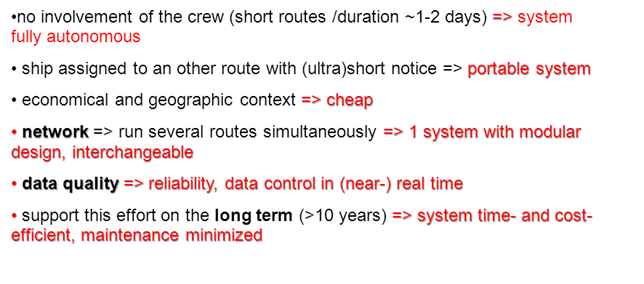1. The pilot phase (2005-2007)
From 2005 to 2007, during the pilot phase, a SeaKeepers 1000TM Module (thermosalinometer plus meteorological sensors) and a fluorometer were installed on the car-ferry "Méditerranée" from the ferry company of Marseille
SNCM.
Legend: The C/F "Méditerranée" operated between Marseilles-Algiers or Marseilles-Tunis at least once per week during summertime.
Although some functionalities were added, issues on quality could not be fixed and the pilot phase was discontinued. Nevertheless it confirmed the value of such a strategy not only for the long term monitoring, but also to capture
extreme events.
2. The TRANSMED system
There are already networks of ships of opportunity to monitor the surface waters (e.g. http://www.ferrybox.org/links/index.html.en ), and for many years now. There are comprehensive systems that exist on the shelf to measure SST, SSS and (bio)geochemical parameters. Besides their cost and the complexity of their installation on board, they are most often conceived as black boxes, and thus cannot be adapted. Moreover, the more parameters measured the more maintenance they require, up to require human intervention while at sea. This is not compatible with the intra-Mediterranean traffic, where there is less than one year of previsibility about the route a vessel is assigned to, and where the duration of a crossing can be less than 24h. This is not compatible either with the need for a network of several ships to achieve a good spatial coverage of the whole Mediterranean, nor with the lack of possible maintenance in some harbours and regions. The requirements to implement a Mediterranean network are:

There was no such low-cost fully-autonomous system available on the shelf, so that a TRANSMED prototype had to be designed through the cooperation between the laboratory that has become the
MIO (CNRS/Aix-Marseille University/IRD/UTV) and the
Division Technique de l'INSU, thanks to funding from
CIESM and
HyMeX (a metaprogram from
MISTRALS ). The first TRANSMED implemented system was installed on the container ship
Jolly Indaco, from the Italian company
Linea Messina), servicing mainly the route from Genoa-Marseilles to southern Ionian, an undersampled area and thus of high-ranking priority. The first data came in May 2010.
Legend: the first data from the TRANSMED system in May 2010
The system basically worked well, and met its requirements. However there were some issues to fix.But the situation in Libya kept
the M/V "Jolly Indaco" inactive for ~a year, until she was finally sold in July 2012. Linea Messina helped installing the TRANSMED system on the
M/V "Jolly Grigio" by May 2013, until she was also sold by June 2013. By 2014 Linea Messina had no longer any ship assigned to the Southern Ionian, so that the cooperation is (provisorily?) discontinued.
3. The operational phase
Meanwhile the
HyMeX program decided to equip the route Marseilles-Algiers to study the Dense Water Formation (DWF) in the gulf of Lions during wintertime and its interannnual variability, as well as to monitor the Western Basin surface hydrological and atmospherical parameters, especially the marine conditions leading to extreme events, such as high precipitating events and intense winds. An improved TRANSMED system was designed and installed by February 2012 aboard
the Ro-Ro "Marfret Niolon", from the french
Marseille Fret ( Marfret) shipping company. It was enabled with the functionality to take control of the TRANSMED PC on board, allowing to reboot, debug or change the configuration from the lab., a pre-requisite to operate ships calling in remote harbours, and especially to run the potential
PartnerSHIPs network.
Legend: The Ro-Ro "Marfret Niolon" in Marseille credit I. Taupier-Letage
Legend: The 2-year time series of surface temperature, salinity with computed density acquired on the Marfret Niolon (2012 - 2014).
The TRANSMED system is now fully operational and meets its requirements.